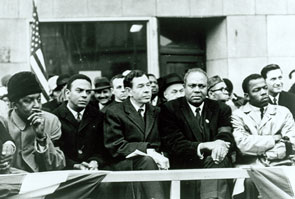Keeping the Faith
African Americans Return to Congress, 1929–1970
Conclusion
 This 1965 picture of civil rights leaders includes, from left to right, future U.S. Representative Andrew Young, then-Representative William Fitts Ryan of New York, James Farmer, and future U.S. Representative John Lewis. Farmer lost a 1968 House race to Shirley Chisholm in a newly created, majority-black district in Brooklyn, New York.Image courtesy of Library of Congress
This 1965 picture of civil rights leaders includes, from left to right, future U.S. Representative Andrew Young, then-Representative William Fitts Ryan of New York, James Farmer, and future U.S. Representative John Lewis. Farmer lost a 1968 House race to Shirley Chisholm in a newly created, majority-black district in Brooklyn, New York.Image courtesy of Library of CongressMany of the changes that occurred during the long generation from 1929 until 1970—brought about by social movements, legal advances, and institutional evolution—profoundly altered the landscape on Capitol Hill for the post–civil rights generation of African-American Members. Compared with their 20th-century predecessors, black Members who came to Capitol Hill in the 1970s would encounter an institution that was more accessible and more favorable to their legislative interests. Court-ordered redistricting in the wake of the Supreme Court’s enunciation of the “one man, one vote” principle, coupled with the Voting Rights Act of 1965, dramatically expanded the rolls of black voters and led to the creation of majority-black districts, paving the way for an increase in the number of blacks in Congress. Until 1968, men had represented the black community almost exclusively, but in the decade after Shirley Chisholm’s election, black women (including some from the South and the West) won election to Congress, portending significant changes in the gender ratio of African Americans in Congress. In 1970, George Collins became the first African American in the 20th century elected to a district that was not majority-black (it would subsequently become majority-black after redistricting). During the next decade this trend accelerated, as districts where blacks did not constitute a majority elected more black Members to the House, including Parren Mitchell of Maryland, Ronald Dellums of California, and Andrew Young of Georgia.139 Long-simmering interest in institutional reform also benefited these newcomers as reformers sought to deprive entrenched committee chairmen of their power and distribute it more evenly among the rank and file. The assignment of a number of incoming black Members to top-tier committees derived from this decentralization of power.
Perhaps the most consequential legacy of Black Americans in Congress from the pioneer era was the drive for organizing black power and interests. By the late 1960s, although African Americans were slowly making inroads in terms of committee assignments, they had relatively little power to command public and institutional attention and sustain a legislative agenda. No African American in either of the major parties held a top elected leadership position in either chamber during this 41-year era.140 Furthermore, the limitations to black Members’ ability to drive legislation were painfully apparent. Representatives Powell and Diggs became adept at garnering publicity, but as Diggs admitted, their efforts amounted to little more than “individualistic policies.”141 The multitude of expectations held by their constituents and black voters outside their districts, doubtlessly magnified black Members’ frustration and sense of isolation.142 Within this context, Diggs’s efforts to create a unified caucus acquired new importance and urgency in the subsequent decade. Diggs’s DSC, which evolved into the Congressional Black Caucus in the early 1970s, provided a forum for black Members to address “black interests” and shape institutional priorities. After decades in a largely unsympathetic and sometimes-hostile political wilderness on Capitol Hill, African Americans stood on the verge of achieving unprecedented influence.
Footnotes
- Swain, Black Faces, Black Interests: 117; David E. Rosenbaum, “3 White Districts Choose Negroes for House Seats,” 5 November 1970, New York Times: 28.
- Shirley Chisholm, elected in 1968, would serve as secretary of the Democratic Caucus in the 1970s.
